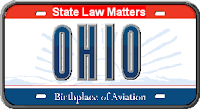 As we posted last week, the Bureau of Underground Storage Tank Regulations (BUSTR) were updated last fall to allow current landowners to address certain BUSTR releases under the Ohio Environmental Protection Agency's (OEPA) Voluntary Action Program or the "VAP". [Don't you just love all these acronyms?] Below is a brief summary of some other rule changes that will soon take effect and pending legislation.
As we posted last week, the Bureau of Underground Storage Tank Regulations (BUSTR) were updated last fall to allow current landowners to address certain BUSTR releases under the Ohio Environmental Protection Agency's (OEPA) Voluntary Action Program or the "VAP". [Don't you just love all these acronyms?] Below is a brief summary of some other rule changes that will soon take effect and pending legislation.1. BUSTR Rule 13 -- Correct Action Rule
BUSTR amended its Corrective Action Rule (Rule 13) to equate an OEPA Covenant Not to Sue to a BUSTR NFA. This amendment takes effect July 1, 2012 (OAC 1301:7-9-13(R)(3)). If the CNS is not upheld then BUSTR will revoke the NFA.
2. BUSTR Rule 19 -- Operating Training
- Class A Operator - Upper Level Manager
- Class B Operator - Field Supervisor
- Class C Operator - Hourly Worker
Each UST system or group of UST systems at a facility must have a Class A, Class B and Class C operator designated. The operators can be trained according to their classification with Class A operators having the most extensive training. Training programs may be held by the State of Ohio or a third party that has received prior state approval. There are currently 14 approved trainers for Ohio's UST program.
3. BUSTR Rule 12 - Out of Service Tanks
4. Senate Bill 294
- the person conducting the voluntary action is not the responsible party for the BUSTR release;
- The BUSTR release is addressed in conjunction with a non-BUSTR regulated release of hazardous substances or petroleum; and
- an escalated enforcement action has not been initiated (i.e., the fire marshal has not issued an enforcement order or made a referral to the Ohio Attorney General's office).
For the volunteer to participate in the VAP, the release must be an identified release, meaning an environmental assessment of some type (closure, Tier 1 or Phase 2) showing contamination above BUSTR action levels must have been performed and that data has been submitted to BUSTR. The volunteer may arrange for the environmental assessment and then submit it to BUSTR.
Current owners beware--If there are any out of service USTs on your property that have been in use in the past few decades and there have not been any environmental assessments conducted on these USTs to see if there has been a release then you may be a responsible party under Ohio law.
_________________________



